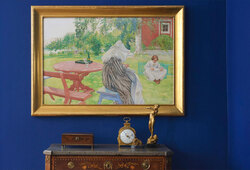A pair of horseshoe-back armchairs, Qing dynasty (1644-1912).
Each constructed with a horseshoe-shaped arm resting on two back stiles, centred with a back splat carved with a ruyi motif, flanked by cusped upper edges, the arms supported on each side with an elongated S-shaped brace and a post, each post decorated with a shaped spandrel. Apron carved with scrolling tendrils, the sides and back with plain straight aprons, all above stretchers joining the side and back legs near the feet and a shaped footrest at the front atop a plain straight apron. Height back 96 cm. Height seat 48,5 cm. Width 63 cm.
Restored, added to.
Alkuperä - Provenienssi
The Stenbeck Collection. Purchased in Hong Kong in the 1980's.
Stenbeck was for many years the presiedent of the Swedish Oriental Ceramics Society. His collection has been vast and unusual in comprising a wide range of Chinese porcelains produced primarily between 1620 and 1683, for the domestic, Japanese and Dutch markets. But he has also had a passion for Chinese furniture and Wanli porcelain.
Having studied, collected and exhibited these splendid wares for almost forty years, Stenbeck now feels that it is time to offer part of his collection at auction. Bukowskis is pleased to have been able to sell items from this impressive collection during several auctions, see for example sale 568 and onwards.
Näyttelyt
For similar armchair see lot 3641, Sothebys. IMPORTANT CHINESE ART, 03 OCTOBER 2017 | 2:00 PM HKT
HONG KONG.
Kirjallisuus
Horseshoe-back armchairs are derived from chairs of nearly identical shape made of pliable lengths of bamboo, bent into a U-shape and bound together by natural fibers. These chairs were lightweight, sturdy, and strong. Fast growing and plentiful, bamboo was powerfully evocative to sophisticated urban dwellers of a simpler, rural life.
The bamboo horseshoe-back armchair was an appealing design due to its lightweight, sturdy and practical form. Moreover, bamboo has many positive associations in Chinese culture. Over time, this popular design was interpreted in wood. The cabinet maker had to either bend the wood to make the curved crestrail, which was not possible with dense tropical hardwoods, or construct it of lighter, less durable woods that did bend. Desiring to use beautiful tropical hardwoods, cabinet makers found a solution in an ingenious joinery technique that applied an equal amount of pressure to two sides of two interlocking slightly curved elements. The two pieces fit together with a cut-out to accommodate a tapered wood pin that when inserted put pressure on the two pieces, locking them firmly in place.
A series of these joins connected together, each forming a section of the overall curve of the U-shaped crestrail, created a single, strong unit. When lacquered, the underlying joinery was not visible and virtually impossible to wrest apart. For chairs made of huanghuali, zitan, or other hardwoods, the beauty of the wood grain enhanced the appeal, and the sections were reinforced by hot animal glues.





























































